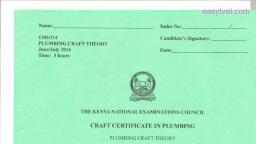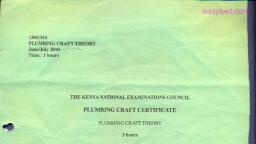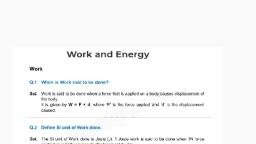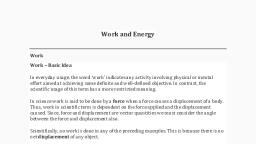Page 1 :
1, , Force, work,, energy and power, , UNIT, , We use forces to do things – to start things moving, to make them, accelerate or decelerate, to change their shape. When a force, changes the energy of something in this way, we say that it does, work. Energy has been transferred., , Key words, • work, • joule, • �conservation of, energy, , Gravity pulls, you straight, down:, W � Fx, , F, , Gravity pulls you straight down: W = Fx, , x, , work done = energy transferred, , ✔Quick check 1, , Doing work, When a force F pushes an object for a distance x, the work W done by the force is Fx., , Module 3, , Take care when using W = Fx! The displacement x must be measured along the direction, of the force., work done = force × displacement in the direction of the force W = Fx, y, x, , Although both force and displacement in a particular direction are vector, quantities, their product (work done) is a scalar. Energy and work are, both scalar quantities., , F, , Gravity pulls you down the slope, but the displacement, in the direction of the force is x, not y; W � Fx, , If the force acts at an angle to the distance moved, such that the angle, between F and x is U, we must consider the component of F in the, direction of x. The equation for work done becomes:, , ✔Quick check 2, 3, , work done W = Fx cos U, F, u, , x, , Defining the joule, Since work done tells us how much energy is transferred by a force, both work and, energy are measured in the same units, called joules (J). The equation W = Fx relates, joules to newtons and metres., 1 joule = 1 newton × 1 metre; 1 J = 1 N m, , ✔Quick check 4, , 1 joule is the energy transferred when a force of 1 newton moves through 1 metre., Equally, it is the energy transferred when a force of 0.5 N moves through 2 m, and so, on. So, in fundamental units, 1 J = 1 N m = 1 kg m s–2 m = 1 kg m2 s–2., , Energy conservation, Energy can take many different forms – thermal (heat), kinetic, gravitational potential,, etc. It can be changed from one form to another, but the total amount always remains, constant. This is the principle of conservation of energy:, In a closed system, the total amount of energy remains constant., This is represented in a Sankey diagram on the next page. The total width of the arrow, remains constant, but it divides to show the proportions which change from one form, to another., 22, , 050_Physics RG.indd 22, , 28/2/08 15:21:13
Page 2 :
Force, work, energy and power, Although energy cannot be created or destroyed, it can be wasted., In other words, when we change energy from one form to another,, some may ‘escape’ in a form that we do not require and cannot use., (Usually this is heat, often it is sound.) The efficiency of an energy, change tells us the fraction of the initial energy that ends up in, useful forms, and is usually expressed as a percentage:, , Output energy, in three forms, Input energy, , useful output energy, , × 100%, efficiency = ____________________, total input energy, Note that efficiency is nearly always less than 100%, because heat, energy is lost. (An electric heater could be considered to be 100%, efficient.), , Worked example, , 24%, [1.2 J], , Input energy, 100% [5 J], Waste, energy, (heat), , STEP 1 Identify the useful output energy. In this case, it is light, energy = 1.2 J, STEP 2 Calculate the efficiency., 1.2 J, × 100% = 24%, Efficiency = _____, , 5.0 J, , Module 3, , A light-emitting diode (LED) is supplied with 5.0 J of electrical, energy each second, and produces 1.2 J of light energy and 3.8 J, of heat energy. What is its efficiency?, , Useful energy (light), , 76%, [3.8 J], , ✔Quick check 5, , Power, Power, P, is the rate of doing work, or the rate of transferring energy:, work done, W, , power = ___________ P = ___, t, time taken, Power is measured in watts, W., 1 watt = 1 joule per second 1 W = 1 J s–1, 1 kilowatt = 1 kW = 1000 J s–1, , QUICK CHECK QUESTIONS, , ?, , ✔Quick check 6, 7, , 1 In the diagram at the top of the opposite page, gravity does 2500 J of work on the person, as they fall. How much energy is transferred by this force?, , 2 A car’s engine provides a forward force of 500 N. It is opposed by a resistive force of 200 N., The car accelerates forwards for 20 m. How much work is done by each force? By how much, does the car’s energy increase?, 3 In the lower diagram on the opposite page, the person’s weight F is 400 N and the distance, they slide down the ramp is 8 m. If the angle of the slope to the horizontal is 30°, use the, equation W = Fx cos θ to calculate the work done by F in pulling them down the slope., 4 Show that 1 J = 1 kg m2 s–2., , Hint, Take care! The angle, between F and x is not, 30°., , 5 A light bulb is supplied with 60.0 J of electrical energy each second. It produces 58.5 J of heat, energy in this time. What is the efficiency with which it produces light?, 6 The engines of a light aircraft provide a power of 50 kW. How much energy do they transfer, in 1 minute?, 7 Calculate the power of an engine which transfers 30 kJ in 1 minute., , 23, , 050_Physics RG.indd 23, , 28/2/08 15:21:14
Page 3 :
1, , UNIT, , Key words, • kinetic energy, • �gravitational, potential energy, , Kinetic and potential energy, Two important forms of energy are kinetic energy (KE) and potential energy (PE)., Potential energy may be due to the position of an object in a gravitational field, (gravitational potential energy, GPE), or due to its shape (elastic potential energy,, explained on page 26)., , Kinetic energy, A moving object has kinetic energy Ek, which depends on its mass m and its velocity v., Like all forms of energy, KE is measured in joules (J)., , Module 3, , To calculate KE, we use:, 1, mv2, Ek = __, 2, Notice that this has the correct units of kg m2 s–2., , Worked example, , ✔Quick check 1, 2, , A car of mass 800 kg is moving at 15 m s–1. What is its KE?, 1, Substituting in Ek = __, mv2 gives:, 2, Ek = ½ × 800 × 152 = ½ × 800 × 225 = 90 000 J, , Gravitational potential energy, When an object of weight mg is raised through a height h, work is done against gravity., The energy given to the object as a result is called its gravitational potential energy, (GPE). This is increased by an amount Ep given by:, gain in GPE = weight × gain in height; Ep = mgh, An object’s GPE increases as it moves upwards (h is positive) and decreases as it moves, downwards (h is negative)., , ✔, , Quick check 3, 4, , Note that the equation ‘gain in GPE = weight × gain in height’ is a form of the equation, that defines work done, with force = weight and distance moved = gain in height., , 24, , 050_Physics RG.indd 24, , 28/2/08 15:21:15
Page 4 :
Kinetic and potential energy, , KE and GPE changes, There are many situations where an object is moving up and down, and there is an, interchange between KE and GPE. If no energy is lost as heat, we can assume that the, change in KE is equal (and opposite) to the change in GPE. (This is an example of the, principle of conservation of energy.), , Hint, Air resistance results in, the loss of energy as, heat., , We can write this as an equation,, , ✔Quick check 5, , Ek + Ep = constant, , Worked example, A stone falls from a height of 5 m. How fast is it moving when it reaches the ground?, , Module 3, , STEP 1 The decrease in the stone’s GPE as it falls is equal to its gain in KE., 1, mgh = __, mv2, 2, STEP 2 Cancel m from both sides:, 1, gh = __, v2, 2, STEP 3 Substitute values and solve for v:, 9.81 m s–2 × 5 m = 0.5v2, v2 = 98.1 m2 s–2, v = 9.9 m s–1, Note that the fact that m cancels out means that we would get the same answer, for any value of m, i.e. all stones of whatever mass would fall at the same rate, (neglecting air resistance)., , QUICK CHECK QUESTIONS, 1 A stone of mass 2 kg is moving at 20 m s . What is its KE?, –1, , ✔Quick check 6, 7, , ?, , 2 A car of mass 600 kg accelerates from 10 m s–1 to 20 m s–1. By how much has its KE, increased?, 3 A car of mass 1000 kg is travelling at 20 m s–1. What is its kinetic energy? It climbs a hill, 200 m high. By how much does its gravitational potential energy increase?, , Hint, Calculate the two, values of KE, and, subtract., , 4 An aircraft of mass 400 000 kg is travelling at a height of 8000 m. It increases its height to, 9500 m. By how much does its GPE increase? (In this example, use g = 10 m s–2.), 5 As a stone falls, its GPE decreases by 20 J. By how much does its KE increase? What, assumption is made in answering this question?, 6 A rollercoaster car of mass 2000 kg runs downhill from a stationary start. If it runs, downwards through a vertical height of 25 m, calculate its KE and speed at the foot of the, hill. (Assume there are no frictional energy losses.), 7 A stone falls 5 m under gravity. Assuming that 2% of its energy is lost due to air resistance,, with what speed is it moving at the lowest point of its fall?, , 25, , 050_Physics RG.indd 25, , 28/2/08 15:21:23
Page 5 :
1, , UNIT, , Key words, , Module 3, , • tensile, • compressive, • elastic limit, • force constant, • �elastic potential, energy, • stress, • strain, • Young modulus, , Deforming solids, It takes a pair of forces to stretch a solid object; such forces are called tensile. Forces, which squash an object are called compressive. Tensile forces can stretch and break an, object. It is easiest to start by describing how a spring stretches., , Hooke’s law, The greater the load (the force stretching, the spring), the greater its extension, (increase in length). Eventually the load is so, great that the spring becomes permanently, stretched. The graph shows two things:, , x, , x, , • At first the graph is a straight line, so, load F is proportional to extension x;, F ∝ x., , F, 2F, 3F, F, , • Beyond the elastic limit, the spring, does not return to its original length when the load is removed., , Hint, You may find ‘stiffness’, easier to remember, than ‘force constant’., , ✔, , Quick check 1, , The proportionality can be turned into an equation; the constant of proportionality is, called the force constant k., F = kx, k is measured in N m–1. It is sometimes known as the stiffness of the spring. k tells you, how many newtons are needed to stretch the spring by 1 metre., , Elastic potential energy, , Force, F, , Work done, 1, , � 2 Fx, , x Extension, , ✔Quick check 2, 3, , An object that is stretched or compressed elastically is a store of elastic, potential energy. The area under a force–extension graph is equal to the work, done by the force. For a spring when the load is less than the elastic limit, the, area under the graph is ½ × force × distance; this tells you the work done in, stretching the spring, which is known as the elastic potential energy. This can be, calculated as follows:, Elastic potential energy = ½ Fx = ½ kx2, , Stretching a wire, Measure the original length of the test wire using a metre rule; measure its diameter, using a micrometer, and calculate its cross-sectional area., Gradually increase the load on the test wire. For each load, note the reading from the, vernier scale., , Original, length, Test wire, , Vernier, Load, , Millimetre, scale, , Calculate values of stress and strain from values of load and extension, and plot a, stress–strain graph., The extension x of the wire depends on four factors:, • its original length l,, • the load F stretching it,, • the cross-sectional area A,, • the stiffness of the material of which it is made., , 26, , 050_Physics RG.indd 26, , 28/2/08 15:21:36
Page 6 :
Deforming solids, These are combined as follows:, , Hint, , extension, x, strain = __, strain = ______________, , original length, l, , You can think of stress, as the same as, pressure; each is a, force divided by an, area., , load, F, stress = _____, , stress = __, area, A, The greater the stress, the greater the strain that results. For many materials:, , Examiner tip, , stress, ______= constant, strain, and this constant is known as the Young modulus, Y, of the material. Y is measured in, N m–2 or pascals (Pa). Its value is typically expressed in MPa or GPa (millions or billions, of pascals); 1 MPa = 1 megapascal = 106 Pa; 1 GPa = 1 gigapascal = 109 Pa., stress, Young modulus = ______, , , strain, , You may be asked to, describe how you, would determine the, Young modulus of a, metal in the form of a, wire., , For low stresses, below the elastic limit (e.l.), the material will return to its original, length when the load is removed. This is elastic deformation. For higher stresses, the, material becomes permanently deformed. This is plastic deformation., The Young modulus is the gradient of the initial (straight, line) part of the graph. Once the stress reaches its highest, value (the ultimate tensile strength, u.t.s.) the material, will break., Materials may be classified as follows:, , Stress, Stress, u.t.s., u.t.s., , Stress, u.t.s., e.l., , e.l. Strain, Brittle, , Strain, , Ductile, Stress, u.t.s., , Stress, Breaks, BreaksStress, u.t.s., u.t.s., , e.l. e.l., Strain, Strain, Ductile, Ductile, Stress, Stress, u.t.s., u.t.s., , Breaks Stress, u.t.s., , Strain, Strain, e.l. e.l., Brittle, Brittle, , Module 3, , ✔Quick check 4, , Stress–strain graphs, , e.l., Strain, Polymeric, , • A ductile material stretches a lot beyond the elastic limit, e.g. copper., • A brittle material snaps when it reaches the elastic limit, e.g. glass., , e.l. e.l., Strain, Strain, Polymeric, Polymeric, , • A polymeric material does not show linear behaviour, e.g. polyethene., , ✔Quick check 5, , ?, , QUICK CHECK QUESTIONS, , 1 A spring is 1.2 m long when unstretched, and 1.4 m long when a load of 50 N is applied. Its, elastic limit is 80 N. Calculate the extension produced by the 50 N load, and the spring’s, stiffness (force constant)., 2 A spring is stretched elastically by a force of 400 N so that its length increases from 2.0 m to, 2.4 m. Calculate the elastic potential energy stored., 3 A spring of force constant k = 2400 N m–1 is stretched by 5.0 cm. Calculate the elastic, potential energy stored., 4 A stress of 20 MPa is applied to a wire of Young modulus 10 GPa. What strain is produced? If, the wire’s initial length was 0.8 m, what extension does the stress produce?, 5 The table shows stress–strain data for an iron wire. Use the data to plot a stress–strain graph;, deduce the Young modulus for iron; and state whether the wire shows plastic or brittle, behaviour., stress/MPa, , 0, , strain (%), , 0, , 50, 0.025, , 100, , 150, , 200, , 250, , 0.050, , 0.075, , 0.100, , wire breaks, , 27, , 050_Physics RG.indd 27, , 28/2/08 15:21:47
Page 7 :
1, , UNIT, , End-of-unit questions, See Appendix 3 on page 79 for data and equations provided in the examination., , Module 1: Motion, 1 a A quantity may be either a scalar or a vector quantity. Define scalar and vector., b Which of the following quantities are vectors, and which are scalars?, Force, velocity, distance, acceleration, kinetic energy, power., 2 a Write down a word equation that defines acceleration., b The graph shows how the velocity of a car varied during the first part of a journey., Determine the car’s acceleration during the parts of the journey represented by, AB and BC., v /m s�1, B, , 15, , 0, , C, , A, 0, , 10, , 20, , 30, , t /s, , c Copy the graph and add to it to indicate how you would expect the car’s velocity, to change if it was involved in a sudden collision with a brick wall., 3 The diagram shows a heavy load being dragged by two tractors. The tension in each, cable is 20 kN., 20 kN, 30�, 30�, , 20 kN, , Draw a vector triangle and use it to find the resultant of these two forces., 4 A car is travelling at 10 m s–1. The driver accelerates at a rate of 2 m s–2 for 6 s., a How far does the car travel during this time?, b What speed will it reach?, 5 A boy stands on the edge of a cliff. He throws a stone upwards so that it leaves his, hand, 2.0 m above the clifftop, with an initial velocity of 8.0 m s–1. It rises upwards, and then falls vertically downwards to the foot of the cliff., (You may assume that air resistance is negligible throughout the stone’s motion.), a Calculate the greatest height to which the stone will rise (above the point where, it leaves the boy’s hand)., b If the cliff is 20 m high, calculate the stone’s vertical velocity when it reaches the, foot of the cliff., c What is the stone’s average velocity during its motion?, d How much time elapses between the moment when the stone leaves the boy’s, hand and when it reaches the foot of the cliff?, , 28, , 050_Physics RG.indd 28, , 28/2/08 15:21:47
Page 8 :
Unit 1 End-of-unit questions, 6 Describe an experiment to measure the acceleration of free fall g, using a falling, object. State the measurements you would make and how you would deduce the, value of g from them., , Module 2: Forces in action, 7 A box is being pulled along level ground. The diagram shows the horizontal forces, acting on the box., , Pulling force � 140N, Friction � 130N, , a, b, c, d, , Calculate the resultant force acting on the box., If the mass of the box is 40 kg, what is its acceleration?, If the volume of the box is 0.05 m3, what is its density?, The area of the box in contact with the ground is 0.12 m2. What pressure does it, exert on the ground?, , 8 a State the SI unit of force., b Write an equation to show how this unit is related to the kilogram, metre and, second (three of the base units of the SI system)., 9 When the space shuttle comes in to land, it deploys a parachute to slow it down., The graph shows how the horizontal force F on the shuttle varies with time t., F, , Examiner tip, If you are asked to, ‘State . . .’, give a, concise answer, without any, supporting argument, or description., , A, , B, , t, , a The parachute is deployed at point A on the graph. Explain why the force on the, shuttle decreases in the region AB., b Copy the graph. On the same axes, add a further line to show how the shuttle’s, velocity changes., , 10 a �‘The gravitational field strength g at the Earth’s surface is 9.81 N kg–1.’ Explain, what is meant by this statement., b An astronaut measures his weight on Earth as 882 N. He travels to the surface of, Mars, where the gravitational field strength is 3.8 N kg–1. What will be the values, of his mass and weight on Mars?, c Show that 9.81 N kg–1 is the same as 9.81 m s–2., , 29, , 050_Physics RG.indd 29, , 28/2/08 15:21:52
Page 9 :
Unit 1 End-of-unit questions, 11 a With the aid of a diagram, explain what is meant by the moment of a force., �The diagram shows a diving board that projects horizontally from point X. Its, weight (2000 N) acts halfway along its length, as shown. It is supported by, a cable attached 1 m from the far end, which makes an angle of 50° with the, vertical., T, X, , 3m, , 50�, 1m, , 2000 N, , b Calculate the moment of the board’s weight about point X., c Show that the tension T in the cable must be 2074 N if its moment is to, counteract the moment of the board’s weight., , Hint, See Examiner tip on, page 21., , 12 Police investigating a road accident discover that one of the cars has bald tyres; most, of the tread has been worn away. They suggest to the driver that he should have, noticed problems when he attempted to make the car accelerate., a The driver claims that he was travelling at 20 m s–1 when he braked. The police, say that he should have been able to stop in a distance of 40 m if his tyres had, been roadworthy. What would the driver’s deceleration have been if he had, stopped in this distance?, b Police tests show that the driver’s bald tyres could not have provided a, deceleration greater than 2 m s–2. What braking distance would be required if the, car was travelling at 20 m s–1?, c The driver was saved from serious harm in the accident because his car was fitted, with an air bag. Explain how this can reduce the impact force in a collision., , Module 3: Work and energy, 13 An aircraft of mass 100 × 103 kg is moving at 150 m s–1. It reduces its height above, the ground from 5000 m to 3000 m and increases its speed to 200 m s–1. Calculate, the change in its gravitational potential energy, and in its kinetic energy., 14 An experiment is conducted on a rubber cord of unstretched length 2.0 m. The cord, has a rectangular cross-section of dimensions 0.5 mm by 5 mm. The cord is hung, vertically and a weight of 100 N attached to its lower end. Its length increases to, 2.4 m. Calculate:, a the stress in the cord, b the strain, c the Young modulus of the rubber., , 30, , 050_Physics RG.indd 30, , 28/2/08 15:21:53
Page 10 :
Unit 1 End-of-unit questions, 15 A spring is stretched by hanging increasing weights on its end, and its length is, measured for each value of the load. The table shows the results., load (N), , 0, , 10, , 20, , 30, , 40, , length (m), , 0.060, , 0.062, , 0.064, , 0.066, , 0.068, , a Plot a suitable graph and use it to determine the force constant of the spring., b The final load of 40 N does not exceed the spring’s elastic limit. Explain what is, meant by elastic limit., c Use the graph to calculate the strain energy stored when the spring is stretched, by the 40 N load., 16 a Sketch a force–extension graph for a ductile material., b Indicate the regions in which you would expect its behaviour to be elastic, and, where it will be plastic., c State the essential difference between elastic and plastic deformation of a solid, material., , Examiner tip, In an examination you, may be expected to, plot a graph on a grid, printed in the exam, booklet., The axes may be, labelled and units, given, but if not,, choose suitable scales, and label the axes, fully., , Examiner tip, If you are asked to, sketch a graph, the, shape and position of, the curve need to be, correct. Label the axes, if they are not already, labelled for you., , 31, , 050_Physics RG.indd 31, , 28/2/08 15:21:54







































































